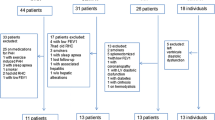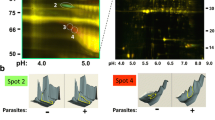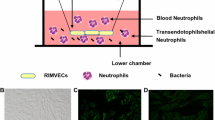Abstract
Endothelial cells control vascular tone, permeability and leukocyte transmigration and are modulated by pro-inflammatory mediators. Schistosomiasis is an intravascular disease associated with inflammation, therefore altering endothelial cells’ phenotype. Purinergic P2X7 receptors (P2X7R) play an important role in inflammation; however, the impact of the disease upon endothelial P2X7R function or expression has not been explored. Using ethidium bromide uptake to investigate P2X7R function, we observed that the effects of ATP (3 mM) and the P2X7R agonist 3′-O-(4-benzoyl)-ATP (BzATP) were smaller in mesenteric endothelial cells from the Schistosoma mansoni-infected group than in the control group. In the control group, BzATP induced endothelial nitric oxide production, which was blocked by the P2X7R antagonists KN-62 and A740003. However, in the infected group, we observed a reduced effect of BzATP and no effect of both P2X7R antagonists, suggesting a downregulation of endothelial P2X7R in schistosomiasis. We observed similar results in both infected and P2X7R−/− groups, which were also comparable to data obtained with KN-62- or A740004-treated control cells. Data from Western blot and immunocytochemistry assays confirmed the reduced expression of P2X7R in the infected group. In conclusion, our data show a downregulation of P2X7R in schistosomiasis infection, which likely limits the infection-related endothelial damage.





Similar content being viewed by others
References
World Health Organization (2012) Schistosomiasis. http://www.who.int/schistosomiasis/en/. Accessed 23 Feb 2012.
King CH, Dickman K, Tisch DJ (2005) Reassessment of the cost of chronic helmintic infection: a meta-analysis of disability-related outcomes in endemic schistosomiasis. Lancet 365:1561–1569
Schramm G, Haas H (2010) Th2 immune response against Schistosoma mansoni infection. Microbes Infect 12:881–888
File S (1995) Interaction of schistosome eggs with vascular endothelium. J Parasitol 81:234–238
Cutts L, Wilson RA (1997) The protein antigens secreted in vivo by adult male Schistosoma mansoni. Parasitology 114:245–255
Jacobs W, Bogers J, Deelder A, Wéry M, Van Marck E (1997) Adult Schistosoma mansoni worms positively modulate soluble egg antigen-induced inflammatory hepatic granuloma formation in vivo. Stereological analysis and immunophenotyping of extracellular matrix proteins, adhesion molecules, and chemokines. Am J Pathol 150:2033–2045
Trottein F, Descamps L, Nutten S, Dehouck M, Angeli V, Capron A, Cecchelli R, Capron M (1999) Schistosoma mansoni activates host microvascular endothelial cells to acquire an anti-inflammatory phenotype. Infect Immun 67:3403–3409
Loeffler DA, Lundy SK, Singh KP, Gerard HC, Hudson AP, Boros DL (2002) Soluble egg antigens from Schistosoma mansoni induce angiogenesis-related processes by up-regulating vascular endothelial growth factor in human endothelial cells. J Infect Dis 185:1650–1656
Michiels C (2003) Endothelial cell function. J Cell Physiol 196:430–443
Carlos TM, Harlan JM (1994) Leukocyte-endothelial adhesion molecules. Blood 84:2068–2101
Pober JS, Sessa WC (2007) Evolving functions of endothelial cells in inflammation. Nat Rev Immunol 7:803–815
Kubes P, Sihota E, Hickey MJ (1997) Endogenous but not exogenous nitric oxide decreases TNF-alpha-induced leukocyte rolling. Am J Physiol 273:G628–G635
Moncada S, Higgs EA (2006) The discovery of nitric oxide and its role in vascular biology. Br J Pharmacol 147:S193–S201
De Caterina R, Libby P, Peng HB, Thannickal VJ, Rajavashisth TB, Gimbrone MA Jr, Shin WS, Liao JK (1995) Nitric oxide decreases cytokine-induced endothelial activation. Nitric oxide selectively reduces endothelial expression of adhesion molecules and proinflammatory cytokines. J Clin Invest 96:60–68
Oliveira SDS, Quintas LEM, Amaral LS, Noël F, Farsky SH, Silva CLM (2011) Increased endothelial cell-leukocyte interaction in murine schistosomiasis: possible priming of endothelial cells by the disease. PLoS One 6:e23547
Yamamoto K, Furuya K, Nakamura M, Kobatake E, Sokabe M, Ando J (2011) Visualization of flow-induced ATP release and triggering of Ca2+ waves at caveolae in vascular endothelial cells. J Cell Sci 124:3477–3483
Faigle M, Seessle J, Zug S, El Kasmi KC, Eltzschig HK (2008) ATP release from vascular endothelia occurs across Cx43 hemichannels and is attenuated during hypoxia. PLoS One 3:e2801
Bodin P, Bailey D, Burnstock G (1991) Increased flow-induced ATP release from isolated vascular endothelial cells but not smooth muscle cells. Br J Pharmacol 103:1203–1205
Burnstock G (1999) Release of vasoactive substances from endothelial cells by shear stress and purinergic mechanosensory transduction. J Anat 194:335–342
Junger WG (2011) Immune cell regulation by autocrine purinergic signaling. Nat Rev Immunol 11:201–212
Ralevic V, Burnstock G (1998) Receptors for purines and pyrimidines. Pharmacol Rev 50:413–492
Burnstock G (2002) Purinergic signaling and vascular cell proliferation and death. Arterioscler Thromb Vasc Biol 22:364–373
Zimmermann H (2000) Extracellular metabolism of ATP and other nucleotides. Naunyn Schmiedebergs Arch Pharmacol 362:299–309
Burnstock G (2006) Purinergic signaling. Br J Pharmacol 147:S172–S181
Wang L, Karlsson L, Moses S, Hultgårdh-Nilsson A, Andersson M, Borna C, Gudbjartsson T, Jern S, Erlinge D (2002) P2 receptor expression profiles in human vascular smooth muscle and endothelial cells. J Cardiovas Pharmacol 40:841–853
Guns PJ, Korda A, Crauwels HM, Van Assche T, Robaye B, Boeynaems JM, Bult H (2005) Pharmacological characterization of nucleotide P2Y receptors on endothelial cells of the mouse aorta. Br J Pharmacol 146:288–295
Wilson HL, Varcoe RW, Stokes L, Holland KL, Francis SE, Dower SK, Surprenant A, Crossman DC (2007) P2X receptor characterization and IL-1/IL-1Ra release from human endothelial cells. Br J Pharmacol 151:115–127
Yamamoto K, Korenaga R, Kamiya A, Qi Z, Sokabe M, Ando J (2000) P2X4 receptors mediate ATP-induced calcium influx in human vascular endothelial cell. Am J Physiol Heart Circ Physiol 279:H285–H292
Harrington LS, Mitchell JA (2004) Novel role for P2X receptor activation in endothelium-dependent vasodilation. Br J Pharmacol 143:611–617
Wihlborg AK, Malmsjo M, Eyjolfsson A, Gustafsson R, Jacobson K, Erlinge D (2003) Extracellular nucleotides induce vasodilatation in human arteries via prostaglandins, nitric oxide and endothelium-derived hyperpolarising factor. Br J Pharmacol 138:1451–1458
Liu C, Mather S, Huang Y, Garland CJ, Yao X (2004) Extracellular ATP facilitates flow-induced vasodilatation in rat small mesenteric arteries. Am J Physiol Heart Circ Physiol 286:H1688–H1695
Harrington LS, Evans RJ, Wray J, Norling L, Swales KE, Vial C, Ali F, Carrier MJ, Mitchell JA (2007) Purinergic 2X1 receptors mediate endothelial dependent vasodilation to ATP. Mol Pharmacol 72:1132–1136
da Silva CG, Specht A, Wegiel B, Ferran C, Kaczmarek E (2009) Mechanism of purinergic activation of endothelial nitric oxide synthase in endothelial cells. Circulation 119:871–879
Silva CLM, Morel N, Lenzi HL, Noël F (1998) Increased reactivity to 5-hydroxytryptamine of portal veins from mice infected with Schistosoma mansoni. Comp Biochem Physiol A Mol Integr Physiol 120:417–423
Silva CLM, Lenzi HL, Silva VFM, Paulo FO, Noël F (2003) Cellular mechanisms involved in the increased contraction of portal veins from Schistosoma mansoni-infected mice. Parasitol Res 89:16–22
Bhardwaj R, Skelly PJ (2009) Purinergic signaling and immune modulation at the schistosome surface? Trends Parasitol 25:256–260
Di Virgilio F (2007) Liaisons dangereuses: P2X7 and the inflammasome. Trends Pharmacol Sci 28:465–472
Lister MF, Sharkey J, Sawatzky DA, Hodgkiss JP, Davidson DJ, Rossi AG, Finlayson K (2007) The role of the purinergic P2X7 receptor in inflammation. J Inflamm 4:5
Lenzi HL, Romana W de S, Santos RM, Rosas A, Mota EM, Manso PP, Caputo LF, Pelajo-Machado M (2006) Four whole-istic aspects of schistosome granuloma biology: fractal arrangement, internal regulation, autopoietic component and closure. Mem Inst Oswaldo Cruz 101:219–231
Silva CLM, Tamura EK, Macedo SMD, Cecon E, Farsky SH, Alves LB, Ferreira ZF, Markus RP (2007) Melatonin inhibits microvascular endothelial cell nitric oxide production in vivo and in vitro. Br J Pharmacol 150:1–11
Marelli-Berg FM, Peek E, Lidington EA, Stauss HJ, Lechler RI (2000) Isolation of endothelial cells from murine tissue. J Immunol Methods 244:205–215
Lowry OH, Rosebrough NJ, Farr AL, Randall RJ (1951) Protein measurement with the Folin phenol reagent. J Biol Chem 193:265–275
Coddou C, Yan Z, Obsil T, Huidobro-Toro JP, Stojilkovic SS (2011) Activation and regulation of purinergic P2X receptor channels. Pharmacol Rev 63:641–683
Schnabel R, Palmer MJ, Kilpatrick IC, Collingridge GL (1999) A CaMKII inhibitor, KN-62, facilitates DHPG-induced LTD in the CA1 region of the hippocampus. Neuropharmacology 38:605–608
Pearce EJ, MacDonald AS (2002) The immunobiology of schistosomiasis. Immunology 2:499–511
Thorgeirsson G, Robertson AL (1978) The vascular endothelium-pathobiologic significance. Am J Pathol 93:803–848
Aird WC (2007) Phenotypic heterogeneity of the endothelium: I. Structure, function, and mechanisms. Circ Res 100:158–173
Vanhoutte PM (2009) Endothelial dysfunction—the first step toward coronary arteriosclerosis. Circ J 73:595–601
Da'dara A, Skelly PJ (2011) Manipulation of vascular function by blood flukes? Blood Rev 25:175–179
Crosby A, Jones FM, Southwood M, Stewart S, Schermuly R, Butrous G, Dunne DW, Morrell NW (2010) Pulmonary vascular remodeling correlates with lung eggs and cytokines in murine schistosomiasis. Am J Respir Crit Care Med 181:279–288
Freedman DO, Ottesen EA (1988) Eggs of Schistosoma mansoni stimulate endothelial cell proliferation in vitro. J Infect Dis 158:556–562
Lejoly-Boisseau H, Appriou M, Seigneur M, Pruvost A, Tribouley-Duret J, Tribouley J (1999) Schistosoma mansoni: in vitro adhesion of parasite eggs to the vascular endothelium. Subsequent inhibition by a monoclonal antibody directed to a carbohydrate epitope. Exp Parasitol 91:20–29
Khakh BS, Burnstock G, Kennedy C, King BF, North RA, Seguela P, Voigt M, Humphrey PP (2001) International union of pharmacology. XXIV. Current status of the nomenclature and properties of P2X receptors and their subunits. Pharmacol Rev 53:107–118
von Albertini M, Palmetshofer A, Kaczmarek E, Koziak K, Stroka D, Grey ST, Stuhlmeier KM, Robson SC (1998) Extracellular ATP and ADP activate transcription factor NF-kB and induce endothelial cell apoptosis. Biochem Biophys Res Commun 248:822–829
Adinolfi E, Pizzirani C, Idzko M, Panther E, Norgauer J, Di Virgilio F, Ferrari D (2005) P2X7 receptor: death or life? Purinergic Signal 1:219–227
Sugiyama T, Kawamura H, Yamanishi S, Kobayashi M, Katsumura K, Puro DG (2005) Regulation of P2X7-induced pore formation and cell death in pericyte-containing retinal microvessels. Am J Physiol Cell Physiol 288:C568–C576
Coutinho-Silva R, Cruz CM, Persechini PM, Ojcius DM (2007) The role of P2 receptors in controlling infections by intracellular pathogens. Purinergic Signal 3:83–90
Coutinho-Silva R, Corrêa G, Sater AA, Ojcius DM (2009) The P2X7 receptor and intracellular pathogens: a continuing struggle. Purinergic Signal 5:197–204
de Jesus AR, Silva A, Santana LB, Magalhães A, de Jesus AA, de Almeida RP, Rêgo MAV, Burattini MN, Pearce EJ, Carvalho EM (2002) Clinical and immunologic evaluation of 31 patients with acute schistosomiasis mansoni. J Infect Dis 185:98–105
Zhang J, Patel JM, Li YD, Block ER (1997) Proinflammatory cytokines downregulate gene expression and activity of constitutive nitric oxide synthase in porcine pulmonary artery endothelial cells. Res Commun Mol Pathol Pharmacol 96:71–87
Bhagat K, Vallance P (1997) Inflammatory cytokines impair endothelium-dependent dilatation in human veins in vivo. Circulation 96:3042–3047
Kofler S, Nickel T, Weis M (2005) Role of cytokines in cardiovascular diseases: a focus on endothelial responses to inflammation. Clin Sci 108:205–213
Herbert DR, Orekov T, Perkins C, Finkelman FD (2008) IL-10 and TGF-beta redundantly protect against severe liver injury and mortality during acute schistosomiasis. J Immunol 181:7214–7220
Gadeock S, Tran JN, Georgiou JG, Jalilian I, Taylor RM, Wiley JS, Sluyter R (2010) TGF-β1 prevents up-regulation of the P2X7 receptor by IFN-γ and LPS in leukemic THP-1 monocytes. Biochim Biophys Acta 1798:2058–2066
Goepfert C, Imai M, Brouard S, Csizmadia E, Kaczmarek E, Robson SC (2000) CD39 modulates endothelial cell activation and apoptosis. Mol Med 6(7):591–603
Agboh KC, Webb TE, Evans RJ, Ennion SJ (2004) Functional characterization of a P2X receptor from Schistosoma mansoni. J Biol Chem 279:41650–41657
Burnstock G, Verkhratsky A (2009) Evolutionary origins of the purinergic signalling system. Acta Physiol 195:415–447
Acknowledgments
The authors thank Dr. Silvana Aparecida Rogel Carvalho Thiengo (FIOCRUZ, Rio de Janeiro, Brazil) for the cercariae donation. This study was supported by Conselho Nacional de Desenvolvimento Científico e Tecnológico (CNPq), Brazil (www.cnpq.br) financial support (472474/2010-3) and fellowship (Suellen D´arc dos Santos Oliveira, Claudia Lucia Martins da Silva and Robson Coutinho Silva); Fundação Carlos Chagas Filho de Amparo à Pesquisa do Estado do Rio de Janeiro (FAPERJ), Programa de Núcleos de Excelência (PRONEX-CNPq) and Instituto Nacional para Pesquisa Translacional em Saúde e Ambiente na Região Amazônica, Conselho Nacional de Desenvolvimento Científico e Tecnológico/MCT (INCT-INPeTAm/CNPq/MCT), Brazil. The funder had no role in study design, data collection and analysis, decision to publish or preparation of the manuscript.
Author information
Authors and Affiliations
Corresponding author
Rights and permissions
About this article
Cite this article
Oliveira, S.D.S., Coutinho-Silva, R. & Silva, C.L.M. Endothelial P2X7 receptors’ expression is reduced by schistosomiasis. Purinergic Signalling 9, 81–89 (2013). https://doi.org/10.1007/s11302-012-9332-5
Received:
Accepted:
Published:
Issue Date:
DOI: https://doi.org/10.1007/s11302-012-9332-5




